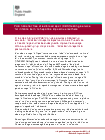Hepatitis B dried blood spot (DBS) testing for infants
Information and service documents on the national DBS testing service offered by PHE to improve uptake of 12 month testing of infants born to hepatitis B infected mothers.
Applies to England
National hepatitis B dried blood spot service
The dried blood spot test or DBS for infants of hepatitis B positive mothers is a national service that is currently offered free of charge by Public Health England (PHE) to increase testing of at risk infants born to hepatitis B positive mothers in the primary care setting.
Recent PHE data suggest that the proportion of infants tested at 12 months is sub-optimal due to difficulties in obtaining venous blood samples in primary care. This places these infants at an increased risk of long term complications if their infections are not recognised and managed early on.
Improving the coverage of vaccination and follow up testing of infants born to hepatitis B positive mothers is therefore an important public health priority.
Dried blood spot testing
PHE has developed a dried blood spot test that has been validated in detecting hepatitis B surface antigen.
The DBS test uses a single- use safety lancet to prick the heel of the infant allowing the healthcare professional to obtain several drops of blood, which are then applied to a filter paper with speed and little discomfort. Simple standard infection control precautions prevent any risk of cross-infection and allowing the blood to air dry onto the filter paper renders it safe for posting to the laboratory.
Joining the service
It is important to note that the DBS service is designed to increase testing in primary care of all at risk infants aged 12 months who are born to hepatitis B positive mothers. It is not intended to replace specialist hospital services that are already established within the local area teams and who continue to offer a timely and efficient testing service.
If you believe the dried blood spot service could help to increase testing in your local area and are interested in joining the service, you should:
- read and check that your organisation is able to meet the essential roles and responsibilities of the service
- express your interest in joining this DBS service by emailing the hepatitis B at-risk infants surveillance team at PHE Colindale at [email protected]
Service documents
PHE has developed a range of documents to support Screening and Immunisation teams to implement the DBS service locally.
The presentation slides ‘How to take a good quality blood spot sample’ for healthcare professionals are available for download.
Medical training video: How to take a dried blood spot sample demonstration video.
Data reports in summary
Testing of infants born to hepatitis B infected mothers: a 3-year review of the national DBS testing service, HPR 11(5), 3 February 2017.
Updates to this page
Published 30 September 2013Last updated 24 August 2021 + show all updates
-
Added revised blood spot sample guide.
-
Updated How to take a dried blood spot test video to include new detail on hexavalent infant vaccine.
-
Updated 'Hepatitis B dried blood spot testing service' and 'Introducing parents to DBS testing' documents due to the introduction of the hexavalent vaccine.
-
Added three-year review of the service (published in HPR 11(5), 3 February 2017).
-
Addition of factsheet on PHE's free dried blood spot testing service
-
First published.




